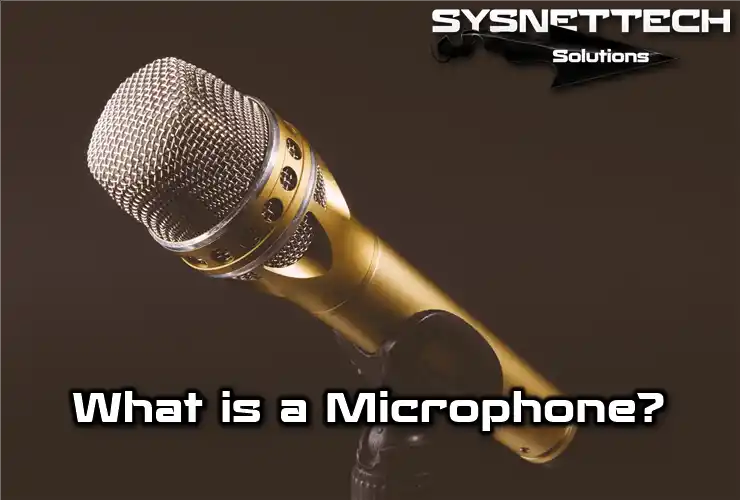A microphone is an electroacoustic transducer that converts sound vibrations into electrical energy. It accomplishes this by capturing acoustic pressure through its capsule and transforming it.
The primary purpose of a microphone is to convert audio signals into electrical impulses. It can process sounds from various locations or elements.

What is a Microphone, and What are its Types?
People use many microphones today, including hand and pendant microphones. Additionally, there are piezoelectric, communication, and studio types. They often use handheld devices for interviews. In the past, pendant-type devices were neck-mounted. However, developers later created neck-clip kinds over time.
The piezoelectric type has divisions into PZ or PZM. It provides the best reception of sounds transmitted from hard surfaces such as tables. So, devices in the communication type capture sound in direct contact with the sound source. People often mount them on musical instruments.
The devices used in studio studies are the most significant microphone type. They contain various application designs. Moreover, all equipment in these categories operates on the sole logic of converting sound waves into electrical energy. Additionally, they have different transducers.
Microphone Types
1) Dynamic Microphone
People consider dynamic devices called moving coils to be the most durable professional equipment. Journalists widely prefer this type of work, as it is beneficial in various challenging conditions.
Their most significant advantage is that they do not need an external power source. Additionally, they are particularly resistant to physical impacts.
Also, people may prefer another type of capacitor due to its smaller size, excellent sensitivity, and the best sound quality.
2) Dynamic Coil Microphone
In such devices, a small coil generates a current from the movement of the membrane or diaphragm.
The main advantages should be cost, robustness, ease of use, and low output resistance. However, disadvantages include slightly varying frequencies and high sensitivity to shock and vibration.
People often use them for loud instruments and outdoor shooting, and they can connect them with long cables.
3) Dynamic Lane Microphone
The only difference between dynamic strips and coiled devices is that metal tape is used instead of a coil. This type has the main advantage of robustness and the ability to operate at medium and low frequencies. However, there are disadvantages, such as weight and unevenness. Additionally, experts recommend them for only a few loud instruments.
4) Condenser Microphone
Also called capacitors or electric condenser microphones, these devices have a quality sound. It is handy and more portable due to its small size. Most capacitor ones are less robust than dynamic ones.
Capacitor devices operate on the principle of an electrical capacitor. These combine with an ultra-thin diaphragm of a flat metal or ceramic piece. A power supply provides an electrical charge between the two elements.
Sound waves hitting the diaphragm cause fluctuations in the electrical charge. The preamplifier needs to amplify these fluctuations. As a result, they integrate the preamplifier into the microphone’s body.
5) Condenser Hardware
Devices in this category require a preamplifier and a power source such as a current or a battery. A capacitor is usually placed in the audio mixer to provide AC power to the microphone.
In such a power system, the cable transmits the microphone’s signal to the console. Additionally, it transfers power to the microphone preamplifier. Ideally, it uses batteries as the power source for the preamplifier. However, due to their limited lifetime, the batteries run out.
Additionally, if one microphone fails, they immediately activate the other. People refer to this technique of using dual microphones as dual redundancy. Moreover, it proves to be much more sensitive than strip equipment. Additionally, they use dynamic and condenser types in television production for different purposes.
6) Piezoelectric Microphone
People pressurize and use piezoelectric devices as purely sound reflection equipment. They limit their usage to specific effects. Moreover, these microphones prove far superior to other types.
7) Contact Microphone
Communication-based devices pick up sound while in physical contact with the source. People often use them on musical instruments. For example, on a piano’s soundboard, acoustic bass surface, or a violin bridge.
Contact or communication microphones do not interfere with any external interference noise. Additionally, they are resistant to sound reflections when colliding with nearby objects.
Directional Properties of Microphones
Like some devices, microphones also have a direction feature. Experts divide these devices into versatile, bidirectional, and unidirectional.
1) Omnidirectional
Omnidirectional microphones are equally sensitive to sounds from any direction. This feature allows more than one person to be around the microphone. Thus, people widely use them in video production.
It also removes unwanted noise while capturing audio from video editing.
2) Bidirectional
Two-way microphones are sensitive to pick up sounds coming from two directions. Although people generally use these equipment in radio interviews and stereo systems, they rarely employ them on TV.
3) Unidirectional
Unidirectional microphones exhibit sensitivity to sounds from only one direction. Experts divide this category into four subcategories.
1. Cardioid
The cardioid uses a sensitivity pattern resembling the shape of a heart. It is sensitive to a wide range of sounds in front of the microphone. However, it is relatively insensitive to sounds behind the microphone.
Studios widely use devices with this model. This is due to their wide range of sensitivity. Moreover, when placed two or more meters away, these can even record unwanted sounds. These sounds include wall reverberation.
2. Supercardioid
Experts consider the super-cardioid more directional than the sensitive model of the cardioid. When directed towards a sound source, it clears interference from sounds outside the focus of perception.
People widely work with these to produce shotgun microphones. Moreover, thanks to their excellent directionality, they work very well at distances between two and five meters.
3. Hypercardioid
Devices known as hyper-cardioid and ultra-directional are even more versatile models. Its narrow response angle feature effectively cleans out-of-range sounds. Additionally, people target it at the sound source. It is why experts include some high-direction shotgun microphones in this category.
4. Parabolic
Parabolic devices have the highest directionality among microphone types. They differ in value from a particular style. Additionally, the reflector forms the polar pattern in this system.
The parabolic reflector can be 1 to 3 feet in diameter. Due to its shape, the microphone can direct all recorded sounds at a narrow capture angle. In addition, they can choose sounds from a distance of 300 feet or more. It is often used in sports coverage, although it is not practical for general production work.



